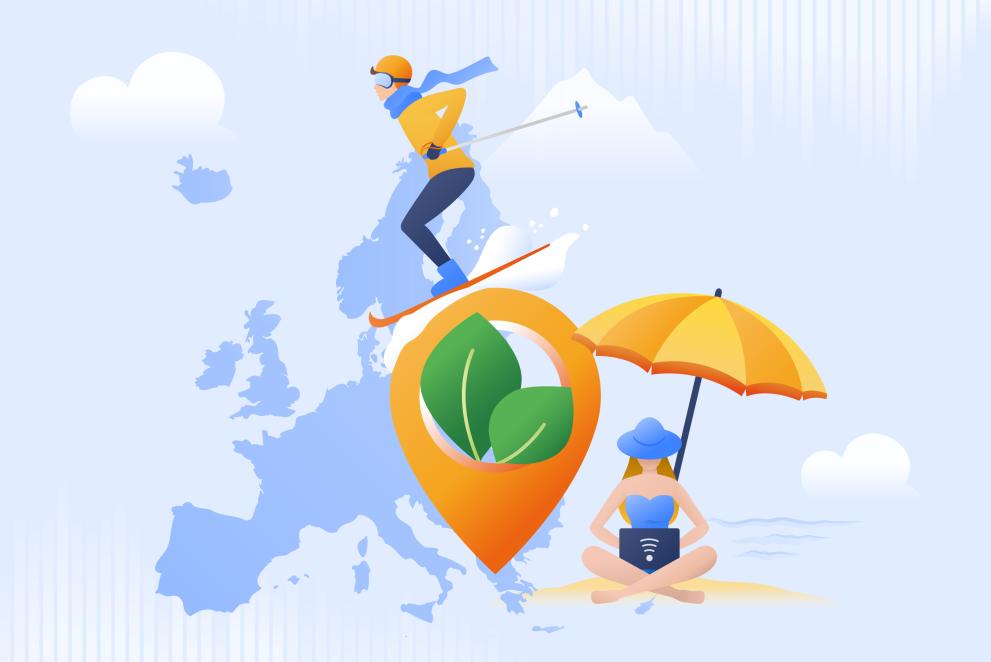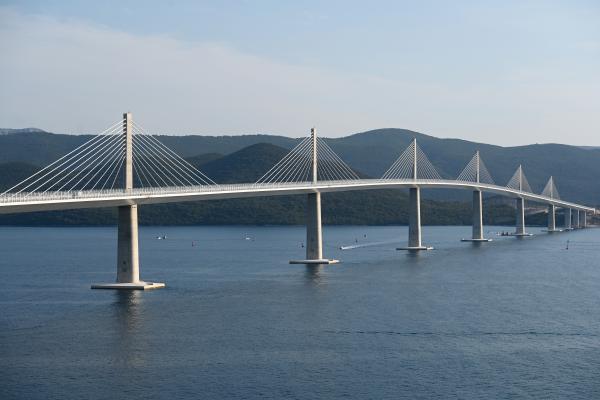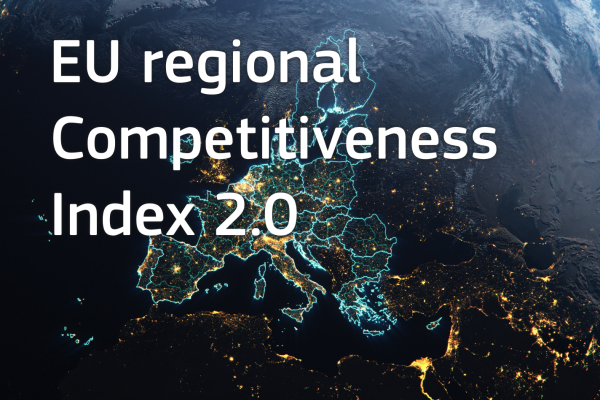EU tourism: an almost full recovery to pre-pandemic levels
The upgraded EU Tourism Dashboard offers insights on the impact and state-of-play of this industry and supports the transition to greener, more digital tourism.

Fresh statistics on EU tourism suggest that in 2022, tourism demand was already at nearly 96% the level in 2019. This shows an almost full recovery on average for the EU , with countries like Belgium, Denmark, France, Ireland, and Netherlands even surpassing pre-pandemic levels.
However, recovery in Eastern European tourism destinations has been more sluggish, possibly also due to the war in Ukraine. Data also shows that international tourism demand is picking up more slowly than domestic tourism, staying in 2022 at 91% the level of 2019.
These new figures result from an update of the EU Tourism Dashboard , an interactive tool providing statistics and indicators relevant for tourism policies . These include, amongst others, the environmental and socio-economic impact in a given area, the level of digitalisation and the main tourism typology.
The recent upgrade has brought updated figures and novel indicators on the adoption of environmental labels and schemes by tourist accommodations, nature-based tourism opportunities and the economic impact of tourism.

A greener and digitalised tourism in the EU
According to the new data, on the digitalisation front, internet infrastructure continues to improve, covering tourism destinations with ever increasing internet speeds: in 2019, only 10% of the tourism capacity had internet speed above 100 Mb/s. This has improved to 42% and 63% in 2021 and 2023, respectively.
On the green front, nearly 850 tourist accommodation establishments had the EU Ecolabel in 2022 or were registered to the EU Eco-Management and Audit Scheme (EMAS) . The EU tourism dashboard also identifies that other 4750 tourist accommodations in the EU countries, Switzerland, Iceland and Norway that have other reliable environmental labels and schemes.
However, the number is still a tiny fraction of the nearly 650,000 tourist accommodation establishments in these countries.
Better data to design policies for a more sustainable tourism
The new data collected and provided in the upgraded dashboard will further help decision makers to identify vulnerabilities and opportunities, and to design effective strategies to make the EU tourism ecosystem more sustainable and resilient to possible shocks, for example encouraging further the adoption of reliable environmental labels and schemes by tourist accommodation establishments.
The EU Tourism Dashboard is a valuable source of knowledge for policy makers in EU countries and regions to better understand how tourism is progressing towards the green and digital transition, and to assess local socio-economic resilience. It can also contribute to the work of statistics experts in EU countries, of researchers, as well as of public and private operators who promote local and regional tourism.
Indicators on the dashboard are organised under three main policy pillars: green, digital and socioeconomic. The dashboard also includes descriptors of tourism demand and supply such as occupancy rates, average duration of stays, presence of UNESCO sites and many more.
Launched in October 2022, the EU Tourism Dashboard was developed by the JRC and the European Commission’s Directorate-General for Internal Market, Industry, Entrepreneurship and SMEs , following a request by EU Member States in 2021 to design a tool for monitoring the twin transition and resilience of the tourism ecosystem – one of the most heavily affected by the travel and health restrictions put in place during the COVID-19 pandemic. The dashboard is developed in cooperation with Eurostat and in coordination with the EU Member States.
The initiative contributes to the Transition Pathway for Tourism published in February 2022, which was created in collaboration with public and private EU tourism stakeholders to identify 27 areas of actions for the green and digital transition and for improving the resilience of EU tourism. Improving statistics and measurements for tourism regarding its economic, environmental and social impacts was recognised among key topics for action.
- Territorial intelligence
Related links
More news on a similar topic.

- News announcement
- 11 April 2024

- General publications
- 5 December 2023

- 9 October 2023

- 27 March 2023
Share this page

- 9 Solutions
- Topics: eGovernment
Commission boosts data sharing and innovation for a sustainable and resilient EU tourism ecosystem
Data sharing and innovation for a sustainable eu tourism ecosystem.
To support the above, on 20 July 2023 the Commission presented the building blocks for a common European tourism data space . This data space will serve all stakeholders in the tourism ecosystem allow them to share a broad range of data to inform the development of innovative tourism services, improve the sustainability of the tourism ecosystem and strengthen its economic competitiveness.
More specifically, the common European Tourism Data Space aims to:
Facilitate data-sharing from diverse sources
Promote data access by a wide range of users
Foster a consistent, trustworthy and efficient framework for the governance of this space
Offer interoperability across data domains, as well as sectoral data spaces (i.e. mobility, energy, environment and health
Get more information below:
Communication on A Common European Data Space
EU Tourism ecosystem
Transition Pathway for Tourism
EU Tourism Dashboard
UDP - Tourism intensity
Collection: LUISA : Land-Use based Integrated Sustainability Assessment modelling platform
The information and links provided are maintained in distributed and heterogeneous information systems. Although we strive to maintain and keep links and information updated, this may not always be possible because of changes that are not registered and updated in the relevant information systems. Please, help us to maintain the system updated by indicating broken links or any other outdated information by contacting the relevant contact point. You can also Contact Us .
Description
Tourism intensity is calculated by dividing the number of nights spent at tourist accommodations by the resident population. It is an indicator of economic dependence on tourism, potentially revealing overtourism and vulnerability to demand shocks when values are very high. Very low values, on the other hand, signal low tourism activity, possibly due to low attractiveness of the destination or untapped potential to develop tourism. Tourism destinations with indicator values around the EU27 average are deemed less vulnerable. This indicator is part of the socio-economic pillar of the EU Tourism Dashboard. UNIT OF MEASURE: Nights spent per inhabitants. RESOLUTION: NUTS0, NUTS2, NUTS3. COMPLETENESS: 100%. METHODOLOGY: TThe indicator is obtained dividing the nights spent by the inhabitants. DATA SOURCES: Nights spent at tourist accommodation establishments by NUTS 2 regions (tour_occ_nin2) [ESTAT], Population on 1 January by age group, sex and NUTS 3 region (demo_r_pjangrp3) [ESTAT].
Contributors
- Ricardo Barranco

How to cite
Batista, Filipe; Ricardo Barranco (2022): UDP - Tourism intensity. European Commission, Joint Research Centre (JRC) [Dataset] PID: http://data.europa.eu/89h/7b8460b8-fc34-4f2b-bd1a-32223d6862c9
Europe inhabitants nights spent tourism tourism intensity
Data access
Reference Eurostat metadata
Publications
Geographic areas.
Switzerland European Union Iceland Norway
KPMG Personalization
- Bahrain: New tourist levy on hotel accommodations
The Ministry of Tourism introduced a new tourist levy on hotel accommodations.
- Home ›
- Insights ›
The Ministry of Tourism introduced a new tourist levy of BHD 3 per room per day on hotel accommodations—effective 1 May 2024.
Read a May 2024 report prepared by the KPMG member firm in Bahrain
The KPMG name and logo are trademarks used under license by the independent member firms of the KPMG global organization. KPMG International Limited is a private English company limited by guarantee and does not provide services to clients. No member firm has any authority to obligate or bind KPMG International or any other member firm vis-à-vis third parties, nor does KPMG International have any such authority to obligate or bind any member firm. The information contained herein is of a general nature and is not intended to address the circumstances of any particular individual or entity. Although we endeavor to provide accurate and timely information, there can be no guarantee that such information is accurate as of the date it is received or that it will continue to be accurate in the future. No one should act on such information without appropriate professional advice after a thorough examination of the particular situation. For more information, contact KPMG's Federal Tax Legislative and Regulatory Services Group at: + 1 202 533 3712, 1801 K Street NW, Washington, DC 20006.
UN Tourism | Bringing the world closer
Share this content.
- Share this article on facebook
- Share this article on twitter
- Share this article on linkedin
UN Tourism International Forum – Quintana Roo “Tourism and Culture: A Picture-Perfect Relationship”
- 19 Apr 2024
Quintana Roo and UN Tourism highlight the potential of audiovisual tourism: Current trends point to the greater dynamism of destinations that promote their cultural and tourism offerings through audiovisual content.
Organized by UN Tourism and the Government of the State of Quintana Roo through the Tourism Promotion Council of Quintana Roo – an entity that is an Affiliate Member of UN Tourism – the International Forum "Tourism and Culture: A Picture-Perfect Relationship" has put the spotlight on the potential of audiovisual tourism to boost the product offerings of destinations and its suitability for tourism marketing and promotion. Participants discussed the creation and implementation of public policies for promotion through audiovisual content, raising awareness among tourists about environmental and cultural protection through on-screen content, as well as the broader relationship between tourism, culture and creative industries.
"As part of the diversification of tourism offerings, audiovisual content can foster relationships and cultural affinity between different countries and communities. Both tourism and the audiovisual sector celebrate and promote culture, foster employment and offer opportunities for growth," said Zurab Pololikashvili, Secretary-General of UN Tourism.
Mara Lezama, Governor of the State of Quintana Roo, said: "I am proud to share that we are moving decisively towards a new era in tourism. We have consolidated public policies that promote the diversification of our tourism offerings, including the cultural segment as one of the fundamental pillars. Our Mexican Caribbean, with its paradisiacal landscapes, its cultural wealth and first-class tourism infrastructure, is positioned as an ideal setting to strengthen our offerings and position Quintana Roo as a leading player in the audiovisual field."
Both tourism and the audiovisual sector celebrate and promote culture, foster employment and offer opportunities for growth
The event was held within the framework of the 11th edition of the Xcaret Platino Awards for Ibero-American Cinema, the largest gathering of the Spanish-speaking audiovisual industry, and brought together experts from the world of tourism and culture.
In the framework of this event, UN Tourism signed a Memorandum of Understanding with the Xcaret Group – an Affiliate Member of the Organization – that lays the foundations for collaboration aimed at jointly promoting good practices in the preservation of cultural heritage, both tangible and intangible, and the welfare of local communities.
UN Tourism, working for the development of audiovisual tourism
UN Tourism has been expanding its work in the field of audiovisual tourism to respond to the increased demand for recommendations and guidance regarding the development of public policies and the sustainable development of this tourism segment. The recent joint UN Tourism – NETFLIX study " Cultural Affinity and Screen Tourism – The Case of Internet Entertainment Services " offers policymakers and tourism sector actors valuable information and recommendations to develop and implement policies that make their destinations attractive to audiovisual producers. Likewise, it aims to help in the formulation of strategies focused on promoting tourism and the consumption of local culture, and investing in training and education to develop the film sector and local creative industries, in order to ensure a high level of talent, infrastructure and production capacity.
Destination Quintana Roo
The State of Quintana Roo continues to strengthen its position as a tourism destination, thanks to large-scale projects such as the launch of the Mayan Train. Quintana Roo received a record number of tourists in 2023, with more than 20 million, and is taking actions to safeguard its cultural and natural heritage, in line with its Quintana Roo 2030 Sustainable Tourism Master Plan.
11th edition of the Xcaret Platino Awards
With the aim of promoting, disseminating and bringing Ibero-American culture and film-making closer together, the Xcaret Platino Awards for Ibero-American Cinema annually brings together the most prominent figures of the Latin American audiovisual industry and recognizes the best audiovisual productions in Spanish and Portuguese.
Related links
- Download News Release on PDF
- UN Tourism Affiliate Members
Related Content
Un tourism: putting communities at the centre of touris..., un tourism members promote investment and education as ..., amadeus & un tourism joint report reveals tourism in th..., resilience through diversity and investments the focus ....

IMAGES
VIDEO
COMMENTS
This section provides information on the 2 main components of tourism statistics: data on tourist accommodation, namely capacity and occupancy of tourist accommodation establishments (for example number of bed places, number of nights spent). Eurostat also publishes a separate series on short-stay accommodation offered via online collaborative ...
The EU tourism dashboard is an online knowledge tool aimed at monitoring the green and digital transitions of the tourism ecosystem to make tourism more resilient and sustainable. The dashboard visualises tourism-relevant data and indicators collected from available, trusted sources covering the tourism ecosystem. It offers snapshot views of ...
Tourism trips: Residents of Luxembourg, Belgium, Malta, Slovenia and the Netherlands made more foreign than domestic trips. 75 % of all trips made by EU residents were inside their own country. EU residents (aged 15 and above) made nearly 1.1 billion tourism trips in 2022, for personal or business purposes. The number of trips increased by 51 % ...
The Commission launches today the EU Tourism Dashboard, a new tool to help policy makers at country and regional level to steer policies and strategies in the tourism ecosystem.The aim of this tool is to improve access to statistics and policy-relevant indicators for tourism, supporting destinations and public authorities in tracking their progress in the green and digital transition.
Countries submit this data to Eurostat within 6 months after the end of the reference year. Usually, in the 4th quarter of the year following the reference year, Eurostat then releases annual data on tourism demand and more detailed annual data on tourist accommodation. For example, data for 2021 were released in the 4th quarter of 2022.
The EU Tourism Dashboard is a valuable source of knowledge for policy makers in EU countries and regions to better understand how tourism is progressing towards the green and digital transition, and to assess local socio-economic resilience. ... The dashboard is developed in cooperation with Eurostat and in coordination with the EU Member States.
Policy context. May 2021 - Council conclusions on Tourism in Europe for the next decade. The European Council invited. the end of 2021". February 2022 - Transition Pathway for Tourism. Implement and use "the EU Tourism Dashboard to support. follow-up of environmental, digital and socio-economic aspects of tourism", with annual updates ...
The EU Tourism Dashboard was developed with the support of the Commission's Joint Research Centre, which will be responsible for the maintenance and continuous development of the tool. The Dashboard responds to a call for such a tool by EU countries in May 2021 and will be further developed and expanded in collaboration with EU countries ...
Commission (Eurostat) publishes first statistics on short-stay accommodation booked via collaborative economy platforms ... Like other European industries, the future of tourism will hinge on our collective ability to transition to a greener, more digital and resilient future. By 2030, Europe should be a top quality destination known globally ...
Eurostat had agreed to share sharing accommodation data with the private sector and on 2021, the Joint Research Centre (JRC) developed the EU Tourism Dashboard tool to monitor the green and digital transitions and resilience of the tourism ecosystem. Also, the European Tourism Agenda 2030 was adopted by the European Council in December 2022 ...
Figure 2: European overview of percentage of population employed in tourism-related sectors, source: Eurostat Tourism decrease caused by COVID-19. Travel bans make tourism one of the industries that is hit the hardest by the COVID-19 crisis. In Europe, several countries already show that the number of nights spent in tourist accommodation was halved in March 2020 compared to previous years.
The European Union is the world's most visited region (see Figure 1). In 2019, the EU-27 received around 539 million international tourist arrivals, almost 37 % of the global total. In the same year, the EU-27's international tourism receipts were €383 billion, 28.9 % of global tourism receipts.
Eurostat also offers datasets that show the preferred destinations for tourists from inside and outside the EU. A good indicator to measure this phenomenon is the total number of nights spent in tourist accommodation establishments, which is available for all guests or only for international guests.. To better understand tourists' preferences, data can be disaggregated to show the type of ...
International Tourism and COVID-19. Export revenues from international tourism dropped 62% in 2020 and 59% in 2021, versus 2019 (real terms) and then rebounded in 2022, remaining 34% below pre-pandemic levels. The total loss in export revenues from tourism amounts to USD 2.6 trillion for that three-year period. Go to Dashboard.
Tourism is a major economic activity in the European Union, accounting for 10% of its GDP, with wide-ranging impact on economic growth, employment and social development. It can be a powerful tool in fighting economic decline and unemployment. EU policy aims to maintain Europe's standing as a leading destination, while maximising the industry ...
Description. Tourism intensity is calculated by dividing the number of nights spent at tourist accommodations by the resident population. It is an indicator of economic dependence on tourism, potentially revealing overtourism and vulnerability to demand shocks when values are very high. Very low values, on the other hand, signal low tourism ...
The EU Tourism Dashboard is an online knowledge portal characterising European tourism destinations in relation to three pillars: green and digital transition, and socio- ... Eurostat tourism statistics Key aspects Approach ―Build on existing indicator systems, build on existing data and frameworks ...
Tourism is a major economic activity in the European Union with wide-ranging impact on economic growth, employment, and social development. It can be a powerful tool in fighting economic decline and unemployment. Nevertheless, the tourism sector faces a series of challenges.
Eurostat data indicates that foreign tourists from the EU and extra-EU countries represented 43.0% of all nights spent in EU tourist accommodations in 2022. In 11 out of the 27 EU countries, the dominant flow consisted of foreign tourists. In three EU countries, international tourists (from the EU and extra-EU countries) accounted for more than ...
If you are looking for some more dashboard tips check the dashboard design guidelines. Learn these 10 design principles to take your dashboards to the next level. Dashboard Design Guidelines not ...
The Ministry of Tourism introduced a new tourist levy of BHD 3 per room per day on hotel accommodations—effective 1 May 2024. Read a May 2024 report prepared by the KPMG member firm in Bahrain. The KPMG name and logo are trademarks used under license by the independent member firms of the KPMG global organization.
Americas. 19 Apr 2024. Quintana Roo and UN Tourism highlight the potential of audiovisual tourism: Current trends point to the greater dynamism of destinations that promote their cultural and tourism offerings through audiovisual content. Organized by UN Tourism and the Government of the State of Quintana Roo through the Tourism Promotion ...
This site uses cookies. Visit our cookies policy page or click the link in any footer for more information and to change your preferences.
Overview In the first quarter of 2024, seasonally adjusted GDP increased by 0.3% in both the euro area and the EU, compared with the previous quarter, according to a preliminary flash estimate published by Eurostat, the statistical office of the European Union. In the fourth quarter of 2023, GDP had declined by 0.1% in the euro area and had remained stable in the EU. These preliminary GDP ...
Overview In March 2024, the euro area seasonally-adjusted unemployment rate was 6.5%, stable compared with February 2024 and down from 6.6% in March 2023. The EU unemployment rate was 6.0% in March 2024, down from 6.1% in February 2024 and stable compared with March 2023. These figures are published by Eurostat, the statistical office of the European Union. Eurostat estimates that 13.258 ...
Overview Euro area annual inflation is expected to be 2.4% in April 2024, stable compared to March according to a flash estimate from Eurostat, the statistical office of the European Union. Looking at the main components of euro area inflation, services is expected to have the highest annual rate in April (3.7%, compared with 4.0% in March), followed by food, alcohol & tobacco (2.8%, compared ...